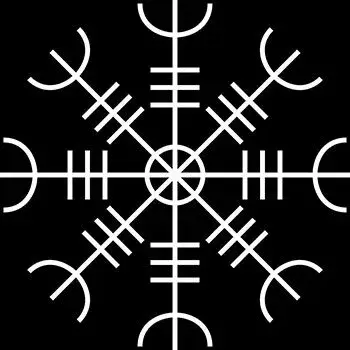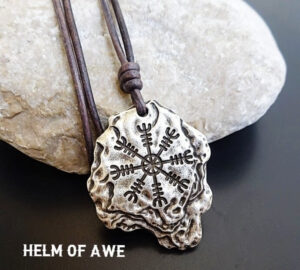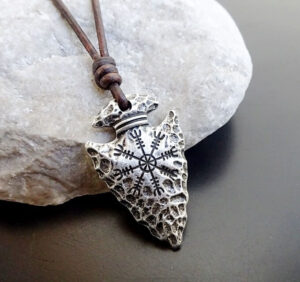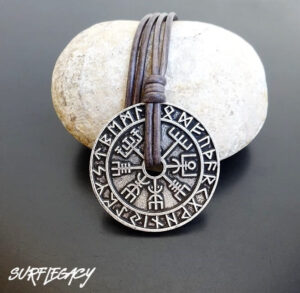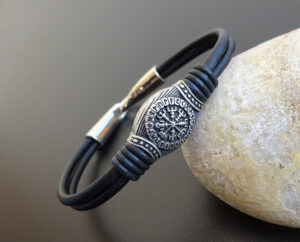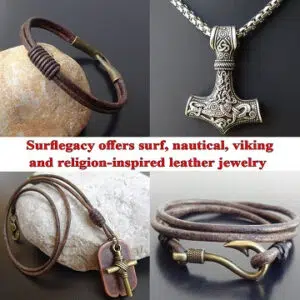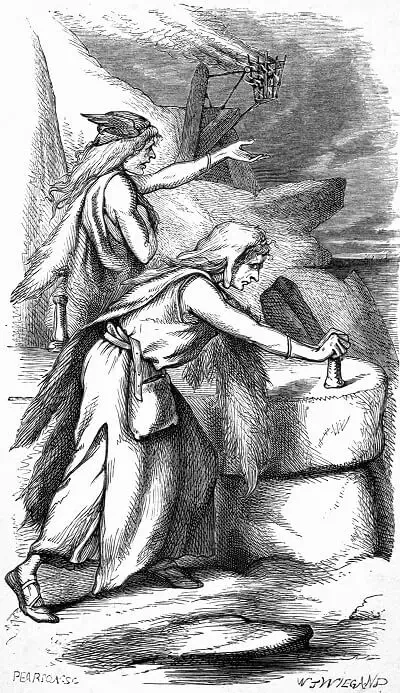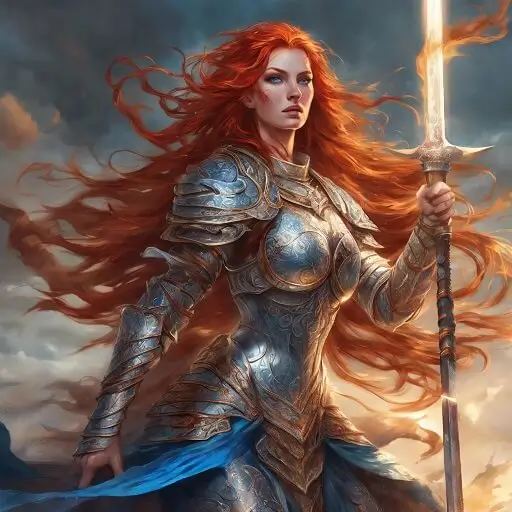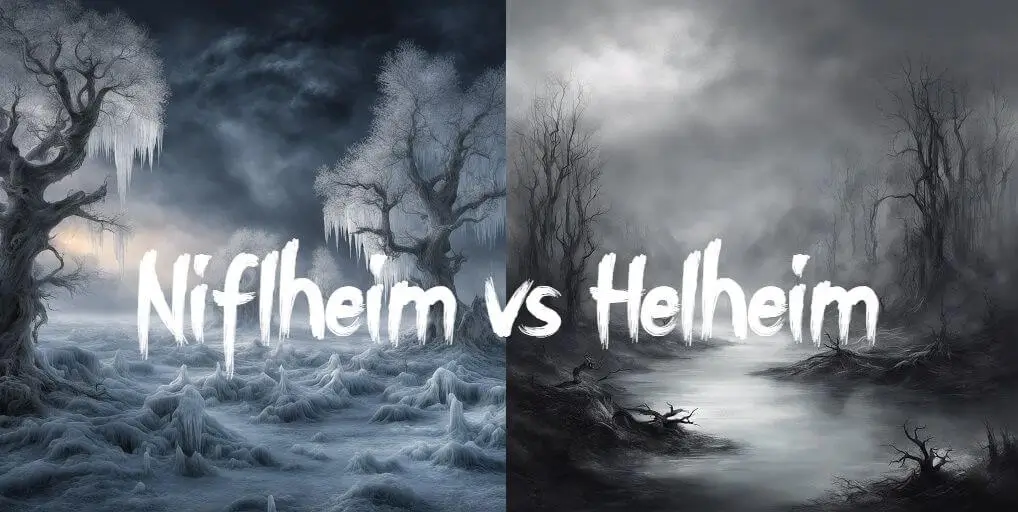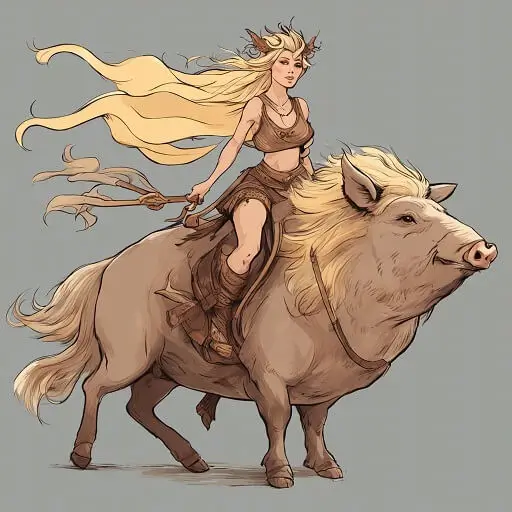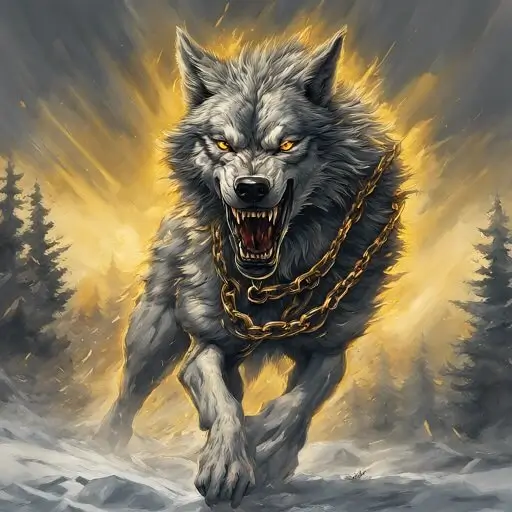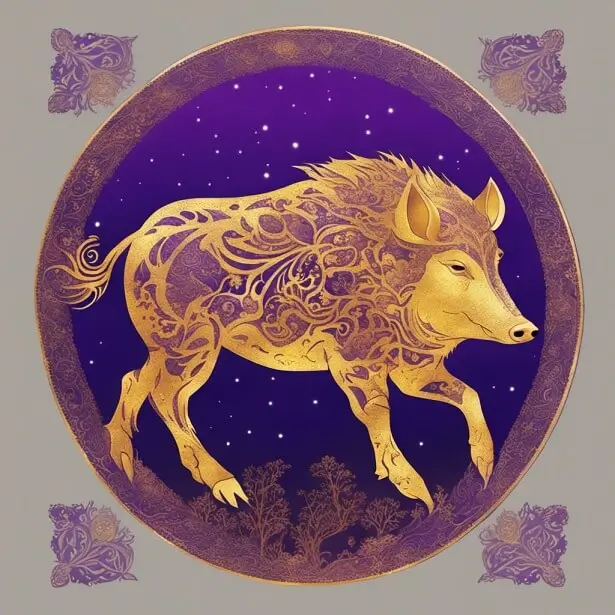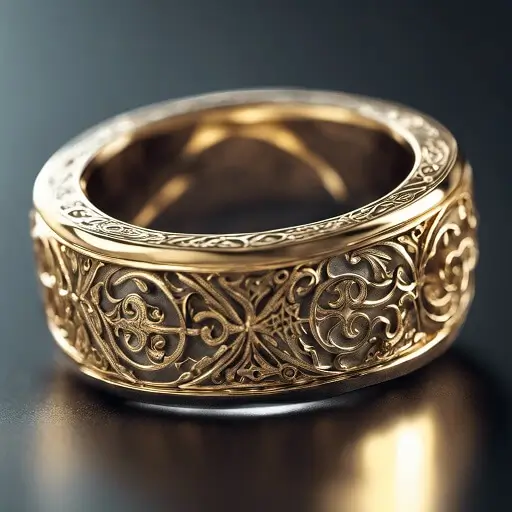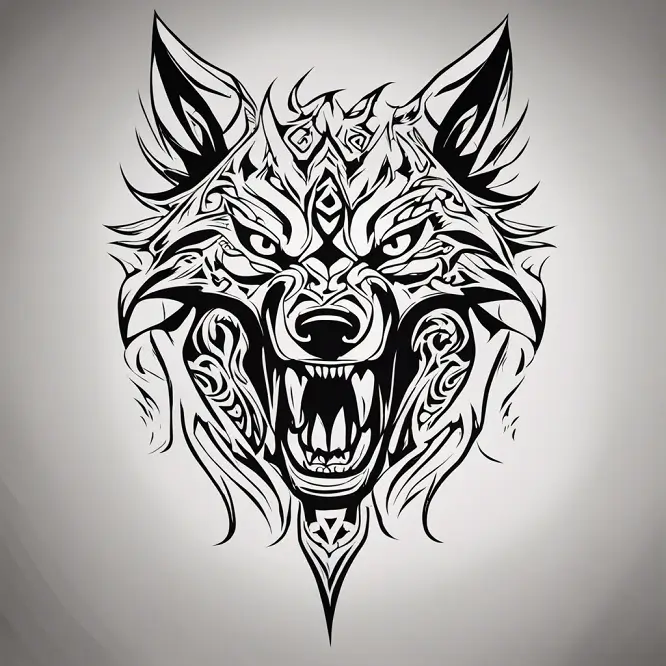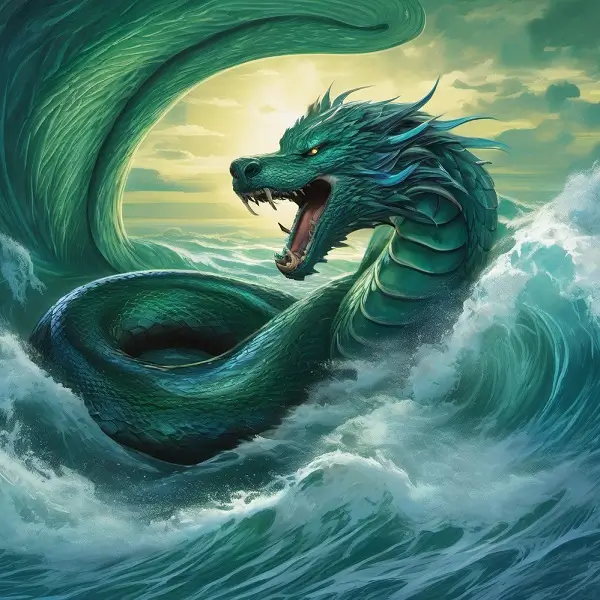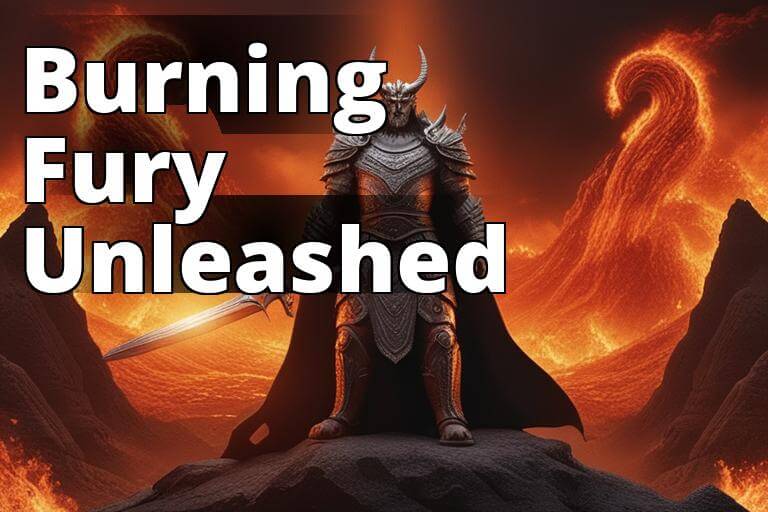In the realm of Norse mythology, the Aegishjalmur or the Helm of Awe stands as a potent emblem of protection. Originating from the Viking Age, this symbol, defined as a ‘protective helm’, has a rich history intertwined with bravery, protection, and mental fortitude.
This blog post will take you on a journey through the Aegishjalmur’s past, exploring its role in Norse sagas, its usage in magical traditions, and its significance. Let’s delve deep into the captivating lore of this enduring symbol, from its ancient roots to its modern adaptations.
The Etymology of Aegishjalmur
The term “Aegishjalmur” is derived from Old Norse, a North Germanic language that was spoken by inhabitants of Scandinavia and their overseas settlements during the Viking Age. The word itself is a compound of two separate words: “Aegis” and “hjalmur”.
“Aegis” in Old Norse refers to “shield” or “protection”, derived from the word “egis”, meaning “of the”. The word “hjalmur”, on the other hand, translates to “helm” or “helmet”. Thus, when combined, the term “Aegishjalmur” can be translated as “the Helm of Protection”, which reflects its symbolic function as an emblem of defense and invincibility.
The Evolution of the Term Through History
The concept of Aegishjalmur has been a part of Norse culture since the Viking Age. Its earliest known mention can be traced back to the ancient sagas, specifically, the Volsunga Saga, a poem from the Poetic Edda that was compiled in the 13th century in Iceland, where it is described as a symbol of protection used by the dragon Fafnir.
The Helm of Awe
I wore before the sons of men
In defense of my treasure;
Amongst all, I alone was strong,
I thought to myself,
For I found no power a match for my own.
Over time, the term “Aegishjalmur” began to evolve and take on new dimensions. It became associated not just with physical protection, but also with psychological strength, imparting bravery and fearlessness to those who invoked it. This transition likely occurred as the sagas were passed down through generations, and the symbol was woven into the fabric of Norse folklore and Icelandic magical traditions.
In the modern era, the term “Aegishjalmur” has retained its original meanings but has also been adapted into various forms of popular culture. It is now recognized globally as a symbol from Norse mythology, often seen in literature, television, film, and is popular in body art and jewelry.
Despite its ancient origins, the Helm of Awe remains a symbol of power, protection, and strength, maintaining its relevance in contemporary society.
The Symbolic Representation of Aegishjalmur
Design and Structure
Aegishjalmur, also known as the Helm of Awe or Helm of Terror, is a powerful Icelandic magical stave that has been used for centuries. It is characterized by its unique design, consisting of an octagonal shape with eight radiating arms or tridents.
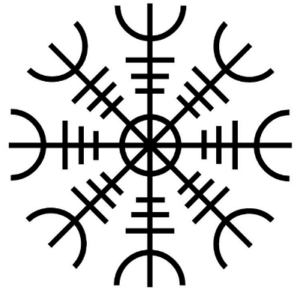
The Helm’s “arms” resemble Z-runes, often referred to as “Algiz” in modern times. Given Algiz’s association with protection and triumph over adversaries, its incorporation into the Helm seems fitting.
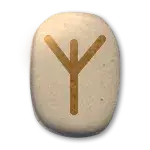
Algiz Rune
The perpendicular “spikes” on the Helm could represent Isa runes. Although Isa’s exact meaning remains unclear due to conflicting primary sources, its name translates to “ice,” suggesting a connection to concentration, hardening, and the fearsome giants of winter’s cold and darkness.
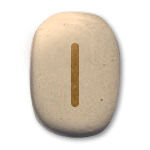
Isa rune
While these connections are speculative and the Isa rune markings are hard to positively identify, the striking alignment between the Helm of Awe’s design and the meanings of these runes is noteworthy.
The overall design creates a wheel-like structure, with the arms reaching out from the center, which may symbolize the protection emanating from the core to the periphery. The symmetrical design ensures that protection extends in all directions. The entire symbol often appears enclosed within a circle, which may represent the cyclical nature of life, or the comprehensive protection offered by the Helm.
Magical Properties
The Helm of Awe is believed to have a variety of magical properties, including the ability to provide protection and strength to the wearer. It is said to create a sense of fear and confusion in one’s enemies, making them easier to defeat. Some also believe that the Helm of Awe can be used to induce sleep or unconsciousness in others.
Significance
The eight arms are said to represent the eight directions, and the three lines on each arm are believed to symbolize the three levels of consciousness: waking, dreaming, and deep sleep. The circle around the central point is said to represent the cyclical nature of life and death.
In Norse mythology, the Helm of Awe is associated with the god Odin, who is often depicted wearing it. It is said that Odin used the Helm of Awe to protect himself and his warriors in battle.
The Aegishjalmur forms part of the Icelandic magical staves, a collection of symbols used in spells and incantations. In this context, it was used as an ‘apotropaic’ symbol – a symbol intended to ward off evil or harm.
Icelandic grimoires, which are books of magic, often depicted the Aegishjalmur as a powerful tool used for personal protection against enemies or harmful energies.
The Helm of Awe thus stands as a testament to the intricate symbolism in Norse culture, encapsulating the fearsome might and protective aura associated with the ancient warriors and their beliefs.
Aegishjalmur in Norse Mythology
Role of the Aegishjalmur in Norse Sagas
The Aegishjalmur has a significant place in Norse sagas, particularly the Volsunga Saga, a legendary saga that tells the story of the Volsung family. The Aegishjalmur is mentioned in relation to the dragon Fafnir, who was once a dwarf but transformed into a dragon as a result of his greed.
Fafnir uses the Aegishjalmur to guard his treasure and to instill fear in the hearts of those who would dare to confront him. He places the Helm of Awe between his eyes, an act that portrays the symbol as a protective talisman against harm. This saga provides the earliest literary mention of the Aegishjalmur and is critical to our understanding of the symbol’s historical and cultural context.
Its Connection with Dragons and Serpents in Norse Mythology
In Norse mythology, dragons and serpents are often associated with immense power, wisdom, and a connection to primal forces. The Aegishjalmur’s connection with the dragon Fafnir suggests a link between this protective symbol and these formidable creatures.
This connection underscores the symbol’s potency, as dragons in Norse mythology are usually associated with strength and terror. The Helm of Awe, therefore, carries the might of the dragon, offering protection to those who wield it and instilling fear in their enemies.
The Use of Aegishjalmur by Viking Warriors for Protection in Battles
In the Viking Age, warriors would often inscribe the Aegishjalmur onto their foreheads or their weapons as a means of protection in battles. They believed that the Helm of Awe would grant them invincibility and courage, shielding them from the enemy’s attacks while also intimidating their opponents.
The Aegishjalmur, thus, served as a psychological tool, bolstering the Viking warriors’ morale and confidence, while simultaneously aiming to strike fear into their adversaries. It is a testament to the deeply ingrained belief in the supernatural and the importance of symbolism in Viking culture.
The Aegishjalmur’s role in the Norse sagas and its association with powerful creatures like dragons underline its significance in Norse mythology. It stands as a symbol of protection and fear, embodying the formidable strength of the Viking warriors and their deep-seated belief in the mystical.
Aegishjalmur in Icelandic Magical Tradition
Galdrastafir
Icelandic magical staves, known as galdrastafir, are intricate symbols with roots in the ancient Norse tradition. These sigils, found in various Icelandic grimoires, were used in spells and incantations, each having a specific purpose or effect. One of the most significant of these grimoires is the Galdrabók, a 16th-century manuscript brimming with various galdrastafir.
In the Galdrabók, one of the symbols that stands out for its potency and ubiquity – is the Aegishjalmur.
The practice of using galdrastafir peaked in the late Middle Ages and continued well into the 18th century.
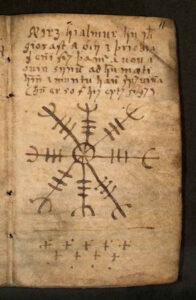
Helm-of-Awe-Ægishjálmr in Galdrabók
The Role and Usage of Aegishjalmur in Spells and Incantations
Within the mystical context of the Galdrabók, the Aegishjalmur could be utilized for a multitude of purposes. Depending on the specifics of the spell or incantation, it might serve to defend against physical harm, repel malevolent spirits, or provide the user with an advantage in conflicts or battles.
The symbol was likely drawn or carved onto various materials for these purposes, including parchment, wood, metal, or even directly onto the skin. Despite its dominant protective function, the Aegishjalmur embodies a broader sense of power, courage, and resilience that permeates the Norse tradition.
In some cases, it was also used in aggressive magic, to create fear and submission in enemies or competitors. The symbol was sometimes inscribed on objects or amulets, which were carried by individuals seeking its protection.
Its Purpose as a Protective Symbol in Icelandic Magic
The primary purpose of the Aegishjalmur in Icelandic magic is protection. It was used to create a metaphysical barrier against physical, mental, or spiritual harm. This aligns with its role in Norse mythology, where it was seen as a symbol of defense and a tool for instilling fear in opponents.
Its secondary purpose was to confer courage and fortitude upon the individual using it. By bearing the Helm of Awe, the user was thought to draw upon the symbol’s inherent power, allowing them to face challenges with confidence and resolve.
The Aegishjalmur’s enduring presence in Icelandic magical tradition underscores its deep cultural significance and the long-standing belief in its protective powers. Today, it remains a potent symbol of protection, courage, and strength in the face of adversity.
Aegishjalmur vs Vegvisir
The Aegishjalmur and Vegvisir, both Icelandic magical staves, are often linked due to their intriguing designs and their roles as powerful symbols within Norse mythology. However, they each carry unique meanings and serve distinct purposes.
The Aegishjalmur, or Helm of Awe, is primarily a symbol of protection and power. Consisting of eight spiked tridents radiating out from a central point, it was believed to instill fear in enemies and shield the bearer from physical, mental, or spiritual harm. The symbol has a strong association with courage, resilience, and overcoming adversity.
On the other hand, the Vegvisir, often referred to as the “Viking compass,” is a symbol of guidance and navigation. Its design, a series of runic staves arranged in a circular pattern, is believed to help one find their way through rough weather, both literally and metaphorically.
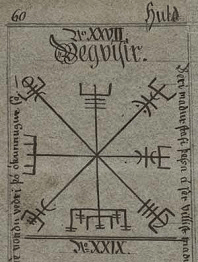
The Vegvisir’s purpose is not to instill fear or offer protection like the Aegishjalmur, but to ensure that one does not lose their way in life’s storms.
In essence, while the Aegishjalmur is a symbol of protection and instilling awe, the Vegvisir is a symbol of guidance and assurance in navigating life’s difficulties. Both carry profound historical and cultural significance and continue to be revered symbols in the modern revival of Norse traditions.
The Modern Perception and Usage of Aegishjalmur
Aegishjalmur in Pop Culture
The Aegishjalmur has found its way into modern popular culture, reflecting our continued fascination with Norse mythology. Its distinctive design has appeared in various forms, from tattoos to jewelry, clothing, and artwork.
In literature, it often appears in fantasy novels with themes or settings inspired by Norse mythology. In the realm of film and television, productions like “Vikings” and “The Last Kingdom” have referenced or depicted the symbol, contributing to its recognition and popularity.
The Symbol’s Role in Norse Pagan Traditions
In Asatru, a modern pagan religious movement seeking to revive ancient Norse religious practices, the Aegishjalmur plays a significant role. Practitioners often use the symbol in rituals for protection, drawing from its historical usage in Norse mythology and Icelandic magic.
The Aegishjalmur is also a popular symbol in Asatru art and jewelry, serving as a visible reminder of the strength, protection, and courage that it represents. Some Asatru practitioners may also tattoo the symbol on their bodies as a personal emblem of these qualities.
Ethical Considerations and Controversies Surrounding Its Use Today
While the Aegishjalmur is widely appreciated for its aesthetic and symbolic value, its use is not without controversy. Some people argue that using such culturally significant symbols outside of their original context can lead to misinterpretation or misuse.
Additionally, like many ancient symbols, the Aegishjalmur has been misappropriated by various extremist groups, leading to discussions about the ethical use of such symbols. It’s essential to approach the Aegishjalmur, and similar symbols, with respect for their cultural origins and an understanding of their historical and contemporary meanings.
Despite these issues, the Aegishjalmur continues to be a symbol of fascination, embodying a rich tapestry of mythology, history, and cultural significance that transcends time and space.
Frequently Asked Questions (FAQs) about Aegishjalmur
Can I wear an Aegishjalmur if I’m not of Norse descent?
Yes, you can. However, it’s important to respect and understand the cultural significance of the symbol. Misappropriation can occur when cultural symbols are used without understanding their historical and cultural contexts.
How was the Aegishjalmur historically created or inscribed?
The historical method of creating the Aegishjalmur would have varied, but it was likely carved or drawn on various materials such as wood, metal, or even directly on the forehead using ash or pigment. Today, it is often seen in tattoos, jewelry, and artwork.
Does the Aegishjalmur have any connection to Viking ships or navigation?
A: While the Aegishjalmur is a symbol of protection that Viking warriors might have used, it doesn’t have a specific connection to ships or navigation. That role is more typically associated with the Vegvisir, another Icelandic stave often referred to as the “Viking compass.”
Citations for All Sources Used in the Blog Post
- Davidson, H. R. Ellis. (1965). Gods and Myths of Northern Europe. Penguin Books.
- Flowers, Stephen. (1989). The Galdrabók: An Icelandic Grimoire. Samuel Weiser Inc.
- Sturluson, Snorri. (2005). The Prose Edda: Norse Mythology. Penguin Classics.
- Price, Neil. (2002). The Viking Way: Religion and War in Late Iron Age Scandinavia. Department of Archaeology and Ancient History.
- Byock, Jesse L. (1990). Saga of the Volsungs: The Norse Epic of Sigurd the Dragon Slayer. University of California Press.
Suggestions for Further Reading for Interested Readers
- Orchard, Andy. (2002). Cassell’s Dictionary of Norse Myth and Legend. Cassell Reference.
- Price, Neil. (2019). Children of Ash and Elm: A History of the Vikings. Basic Books.
- Simek, Rudolf. (1996). Dictionary of Northern Mythology. D.S. Brewer.
- Turville-Petre, E.O.G. (1964). Myth and Religion of the North: The Religion of Ancient Scandinavia. Holt, Rinehart and Winston.
- Pennick, Nigel. (1992). Magical Alphabets. Samuel Weiser.
Shop Norse Jewelry
Are passionate about Vikings or Norse Myths?
Finding the ideal piece of Viking Jewelry can be challenging and time-consuming, especially if you lack inspiration or don’t know where to look.
Surflegacy, has you covered. We have a wide range of Handmade Jewelry in various styles, shapes, colors, and materials, to accentuate your Viking spirit and look. Do not hesitate to visit our selection HERE
Whatever you wear, you’ll find the ideal trendy piece to complement your wardrobe. Our jewelry is designed to be worn every day, no matter where you go or what season is. Are you ready to step up your wardrobe game?

